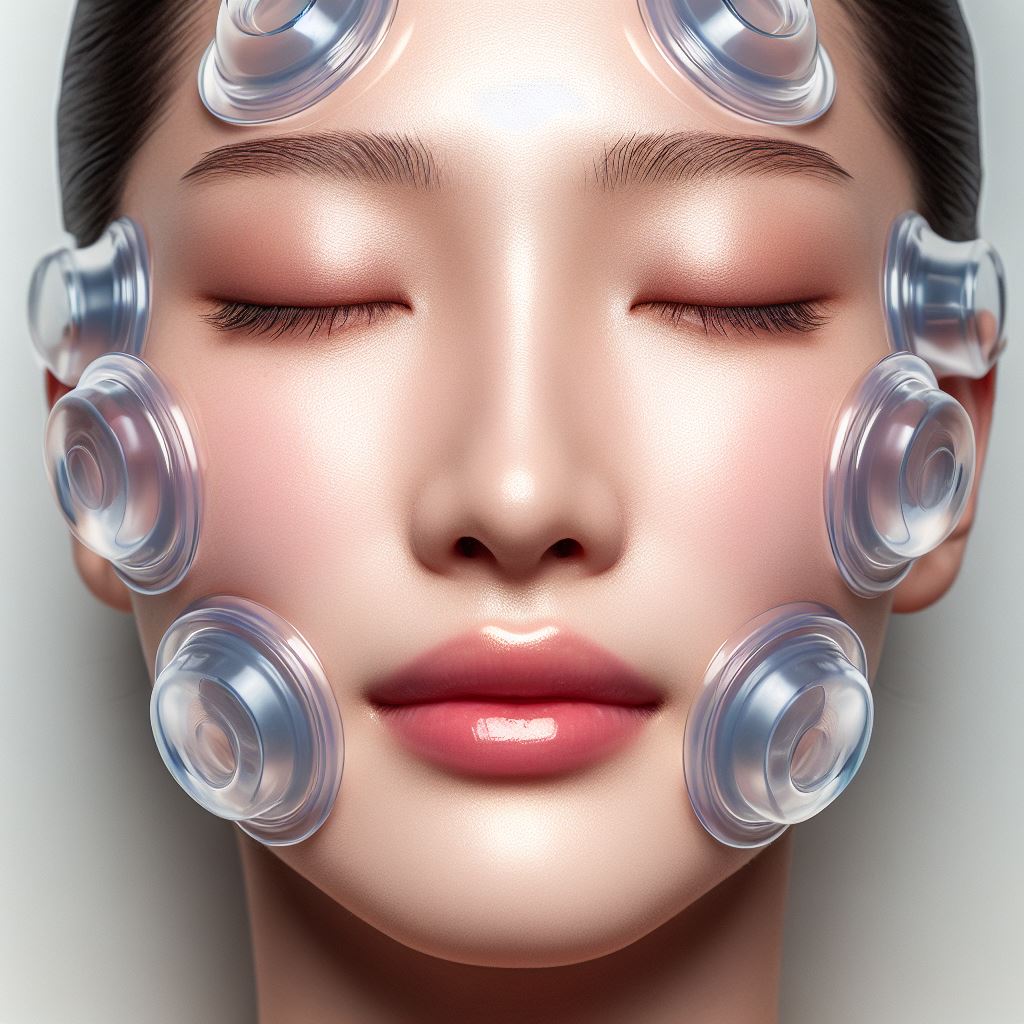Discover the transformative potential of cupping therapy for the face, head, and neck.
This ancient practice offers a holistic approach to address pain, tension, and congestion in these vital areas. By utilizing cups of varying sizes to create suction on the skin, cupping therapy effectively lifts and separates underlying tissues, promoting relief and enhancing overall well-being.
In this article, we will explore the evidence-based benefits of cupping therapy, including pain relief, lymphatic support, and its ability to alleviate symptoms of TMJ dysfunction.
Key Takeaways
- Cupping therapy can alleviate tension and discomfort in the face, head, and neck.
- It can provide relief for conditions such as sinusitis and migraines.
- Cupping therapy promotes lymphatic drainage, reduces congestion, and improves circulation in the affected areas.
- It addresses the underlying causes of headaches, TMJ dysfunction symptoms, and congestion due to thyroiditis, providing regular relief and improving overall management.
Benefits of Cupping Therapy for Pain Relief
Cupping therapy’s pain-relieving benefits are evident in its ability to alleviate tension and discomfort in the affected areas of the face, head, and neck. This ancient therapy has shown promising results in treating conditions such as sinusitis and migraines.
Sinusitis, characterized by inflammation of the sinuses, can lead to facial pain and pressure. Cupping therapy helps to clear congested lymph around the base of the neck, promoting lymphatic drainage and reducing congestion in the neck area. This provides relief to individuals suffering from sinusitis.
Migraines, on the other hand, can be debilitating and affect one’s quality of life. Cupping therapy uses soft tissue release techniques and assists in drainage to address the underlying causes of headaches. Regular cupping sessions can provide relief from migraines and improve overall headache management.
How Cupping Therapy Works for Face, Head, and Neck
When considering the efficacy of cupping therapy for the face, head, and neck, it is essential to understand the mechanisms through which this ancient practice works. Cupping therapy utilizes cups of different sizes to create suction between the cup and the skin tissue. This suction pulls impurities from the inner layers of tissue and muscle, catalyzes lymphatic liquefaction and drainage, and lifts and separates the skin and underlying tissue to move congestion. These actions contribute to various benefits such as facial rejuvenation and improved lymphatic drainage.
To provide a clearer understanding, the following table highlights the key mechanisms of cupping therapy for the face, head, and neck:
| Mechanism | Description | Benefits |
|---|---|---|
| Suction | Creates suction between the cup and skin tissue | Relieves pain and tension |
| Impurity extraction | Pulls impurities from inner layers of tissue | Alleviates chronic inflammations |
| Lymphatic liquefaction | Catalyzes lymphatic drainage and liquefaction | Assists in TMJ disorders |
| Tissue separation | Lifts and separates skin and underlying tissue | Promotes overall wellbeing |
Understanding these mechanisms can help individuals comprehend the effectiveness of cupping therapy for facial rejuvenation and lymphatic drainage.
Cupping Therapy for Relieving Congestion Due to Thyroiditis
Relieving congestion due to thyroiditis can be effectively achieved through the regular use of cupping therapy. Cupping therapy has been found to provide relief for individuals suffering from thyroiditis by improving thyroid health and easing symptoms associated with the condition. Here are five ways cupping therapy can help:
- Enhances lymphatic drainage: Cupping therapy clears congested lymph around the base of the neck, allowing for improved lymphatic flow and reducing congestion in the neck area.
- Promotes overall well-being: By addressing congestion and improving lymphatic function, cupping therapy can help individuals with thyroiditis feel better both physically and emotionally.
- Reduces neck congestion: Cupping therapy helps to alleviate congestion in the neck area, providing relief and comfort for those experiencing discomfort due to thyroiditis.
- Improves circulation: The suction created during cupping therapy can stimulate blood flow, which can aid in the healing process and improve overall thyroid health.
- Supports the body’s natural healing mechanisms: Cupping therapy assists the body in its natural ability to heal by promoting the movement of congestion and impurities, allowing for better functioning of the thyroid gland.
Cupping Therapy for Alleviating Headaches
Cupping therapy offers a potential solution for individuals seeking relief from headaches by utilizing soft tissue release techniques and promoting effective drainage. Whether it’s migraines or tension headaches, cupping therapy can provide regular relief and improve overall headache management.
By using cups of different sizes to create suction on the skin, this therapy pulls impurities from the inner layer of tissue and muscle, addressing the underlying causes of headaches. It also assists in lymphatic liquefaction and drainage, which helps to reduce congestion and relieve pressure in the head and neck area.
With its holistic approach, cupping therapy enhances well-being and quality of life by providing a natural and evidence-based treatment option for those suffering from headaches.
Cupping Therapy for Relieving TMJ Dysfunction Symptoms
Cupping therapy offers a potential solution for individuals experiencing TMJ dysfunction symptoms. It effectively addresses congestion and relieves pressure in the jaw and surrounding areas. Here are five ways cupping therapy can help relieve TMJ dysfunction symptoms:
- Reduces congestion near the jaw and around the ears, providing relief from discomfort.
- Relieves pressure in the TMJ area, allowing for improved function and mobility.
- Creates traction to gently move the soft tissues of the TMJ, promoting relaxation and reducing pain.
- Alleviates TMJ pain, allowing individuals to experience relief and improved quality of life.
- Improves TMJ function and mobility, enabling individuals to perform daily activities with ease.
Cupping therapy for TMJ dysfunction symptoms is an evidence-based approach that offers a holistic solution for stress management and facial rejuvenation. By addressing congestion and relieving pressure in the jaw and surrounding areas, cupping therapy can provide much-needed relief for individuals experiencing TMJ dysfunction symptoms.
Frequently Asked Questions
Are There Any Potential Side Effects or Risks Associated With Cupping Therapy for the Face, Head, and Neck?
Potential risks and side effects of cupping therapy for the face, head, and neck are important considerations. Exploring safety concerns is crucial to understanding the effectiveness of this therapy. Examining evidence and user experiences provides valuable insight.
How Long Does It Typically Take to See Results From Cupping Therapy for These Specific Areas?
The duration of cupping therapy for the face, head, and neck varies depending on individual factors. However, it is important to note that while some individuals may experience immediate results, others may require multiple sessions to see the full effectiveness of cupping therapy.
Can Cupping Therapy Be Combined With Other Treatments or Therapies for Enhanced Results?
Combining cupping therapy with other treatments can enhance results. Cupping therapy has been found effective for facial rejuvenation, relieving pain and tension, promoting lymphatic drainage, and alleviating TMJ disorders.
Is Cupping Therapy Suitable for Everyone, or Are There Any Contraindications or Conditions That May Make It Unsuitable?
Cupping therapy is generally considered safe and suitable for most individuals, but there are certain contraindications. It is not recommended for pregnant women and caution should be exercised for those with chronic pain conditions.
How Often Should Cupping Therapy Sessions Be Scheduled for Optimal Benefits?
For optimal benefits, cupping therapy sessions should be scheduled based on individual needs, severity of symptoms, and treatment goals. Frequency of sessions may vary, but regular sessions are typically recommended to maintain the desired therapeutic effects.
Conclusion
In conclusion, cupping therapy offers a holistic and evidence-based approach to addressing issues related to the face, head, and neck.
By utilizing cups to create suction on the skin, this ancient practice effectively alleviates pain, tension, and congestion while promoting lymphatic support and overall well-being.
Whether it’s relieving symptoms of TMJ dysfunction, addressing congestion caused by thyroiditis, or alleviating headaches, cupping therapy provides a gentle yet powerful solution for improving quality of life in these vital areas.






















